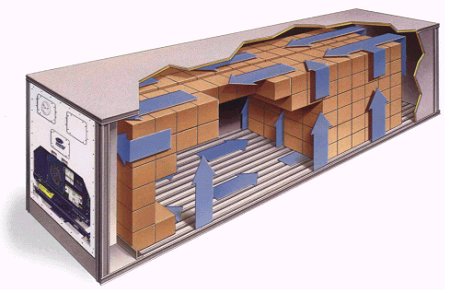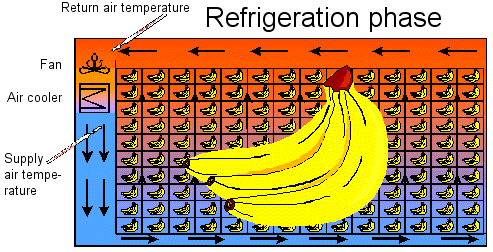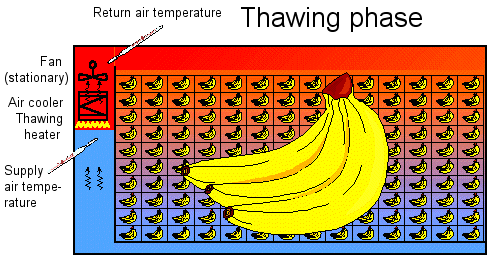 |
| Figure 34: Air flow in a refrigerated container |
The supply and return air temperatures are measured and recorded in the refrigeration unit. Under normal operating conditions the return air temperature is between 0.5°C and 3°C higher than the supply temperature because the return air is carrying the heat from the container itself. This heat is made up of the heat that comes from the ambient environment outside the container through the container insulation, any heat caused by cooling the load, and when transporting fruit the respiration heat of the load itself.
 |
| Figure 35: Air flow and temperature distribution in a refrigerated container during refrigerated operation |
In low-temperature mode, most common refrigeration units control the return temperature using a two-point switching method: As long as the return air temperature is above the nominal value, the refrigeration unit cools at full power. Once the nominal temperature has been reached, the refrigeration unit switches itself off leaving only the fans responsible for circulating the air in the container running. When the return air temperature rises to approximately 0.5°C above the nominal value, the refrigeration unit starts up again and the process is repeated. The supply air temperature must obviously be lower than the nominal temperature.
The circulating fans are operated at low speeds in low-temperature operation to ensure that the air is exchanged at a rate of 30 - 40 times the empty container volume per hour.
From time to time the air cooler must be defrosted in order to prevent it from becoming iced up and thus reducing the flow of air and the transfer of heat. During this process the cooling unit is switched off and the circulating fans are stopped to ensure that no warm air is able to enter the container. The frequency of defrosting can be specified manually. However some refrigeration units are able to determine automatically when defrosting is necessary. In addition, manual defrosting can be triggered at any time using the switch on the refrigeration unit.
 |
| Figure 36: Defrosting a refrigeration unit |
Unlike low-temperature operation, in chilled operation with nominal temperatures above -10°C, the supply air temperature is regulated constantly. The refrigeration unit is running constantly, except when it is defrosting, and the supply air temperature is regulated with the regulating valves in the refrigeration circuit of the refrigeration unit. In addition, in chilled operation the circulating fans run at full power providing an air exchange rate within the container of between 60 - 80 circulations/hour.